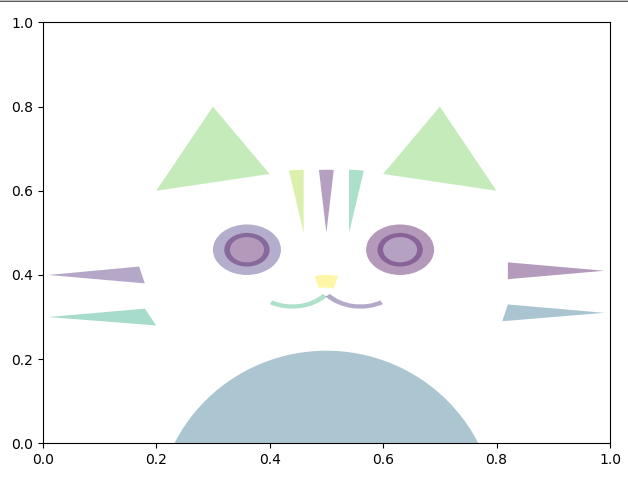1。 画出一个基本的饼图,通过plt.pie()
m = 51212 f = 40742 m_perc = m / (m+f) f_perc = f / (m+f) colors = ['navy', 'lightcoral'] labels = ['Male', 'Famale'] plt.figure(figsize=(8, 8)) # autopct 表示的是使用百分号表示, explode=[0, 0.05]表示两个饼的间隔 paches, text, autotext = plt.pie([m_perc, f_perc], colors=colors, labels=labels, autopct='%1.1f%%', explode=[0, 0.05]) # 对文本添加尺寸大小 text表示外圈文本 for text in text + autotext: text.set_fontsize(20) # 饼图内部的字体颜色 for text in autotext: text.set_color('white') plt.show()
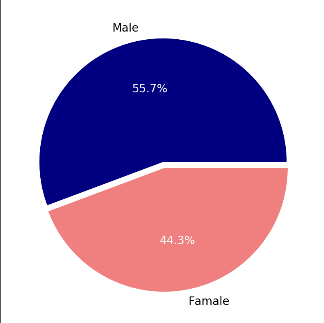
2. 设置子图布局,通过plt.subplot2grid((3, 3), (0, 0))
ax1 = plt.subplot2grid((3, 3), (0, 0)) ax2 = plt.subplot2grid((3, 3), (1, 0)) ax3 = plt.subplot2grid((3, 3), (0, 2), rowspan=3) ax4 = plt.subplot2grid((3, 3), (2, 0), colspan=2) ax5 = plt.subplot2grid((3, 3), (0, 1), rowspan=2) plt.show()
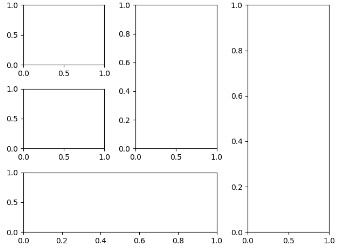
3. 在一个大图里面嵌套一个小图, 通过添加一个坐标系来完成 fig.add_axes([left, bottom, width, height])
x = np.linspace(0, 10, 1000) y2 = np.sin(x**2) y1 = x ** 2 fig, ax1 = plt.subplots() left, bottom, width, height = [0.22, 0.45, 0.3, 0.35] ax2 = fig.add_axes([left, bottom, width, height]) ax1.plot(x, y1) ax2.plot(x, y2) plt.show()
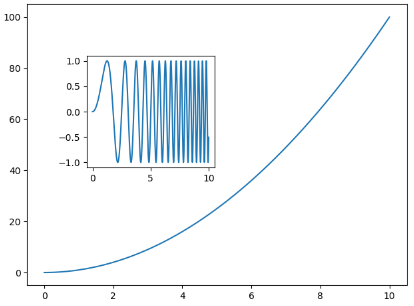
4. insert_axes在第一个图的基础上加入第二个图,这里也做了对条形图的高度加上了文本注释
from mpl_toolkits.axes_grid1.inset_locator import inset_axes top10_arrivals_countries = ['CANADA','MEXICO','UNITED\nKINGDOM',\ 'JAPAN','CHINA','GERMANY','SOUTH\nKOREA',\ 'FRANCE','BRAZIL','AUSTRALIA'] top10_arrivals_values = [16.625687, 15.378026, 3.934508, 2.999718,\ 2.618737, 1.769498, 1.628563, 1.419409,\ 1.393710, 1.136974] arrivals_countries = ['WESTERN\nEUROPE','ASIA','SOUTH\nAMERICA',\ 'OCEANIA','CARIBBEAN','MIDDLE\nEAST',\ 'CENTRAL\nAMERICA','EASTERN\nEUROPE','AFRICA'] arrivals_percent = [36.9,30.4,13.8,4.4,4.0,3.6,2.9,2.6,1.5] # 在每一个条形图上进行文本的添加 def add_text(resc): for bar in resc: height = bar.get_height() # ax1.text 设置文本标签 ax1.text(bar.get_x() + bar.get_width()/2 , height+0.1, '%s'%height, fontsize=18, ha='center', va='bottom') # 条形图的绘制 fig, ax1 = plt.subplots(figsize=(20, 12)) vbar = ax1.bar(np.arange(len(top10_arrivals_values)), top10_arrivals_values) plt.xticks(np.arange(len(top10_arrivals_values)), top10_arrivals_countries, fontsize=18) # 在第一个坐标系的基础上构造第二个坐标系 ax2 = inset_axes(ax1, width=6, height=6, loc=5) explode = (0.08, 0.08, 0.05, 0.05,0.05,0.05,0.05,0.05,0.05) puaches, text, autotext = ax2.pie(arrivals_percent, explode=explode, labels=arrivals_countries, autopct='%1.1f%%') for text in text + autotext: text.set_fontsize(18) for text in autotext: text.set_color('white') # 去除边框的操作 for spines in ax1.spines.values(): spines.set_visible(False) add_text(vbar) plt.show()
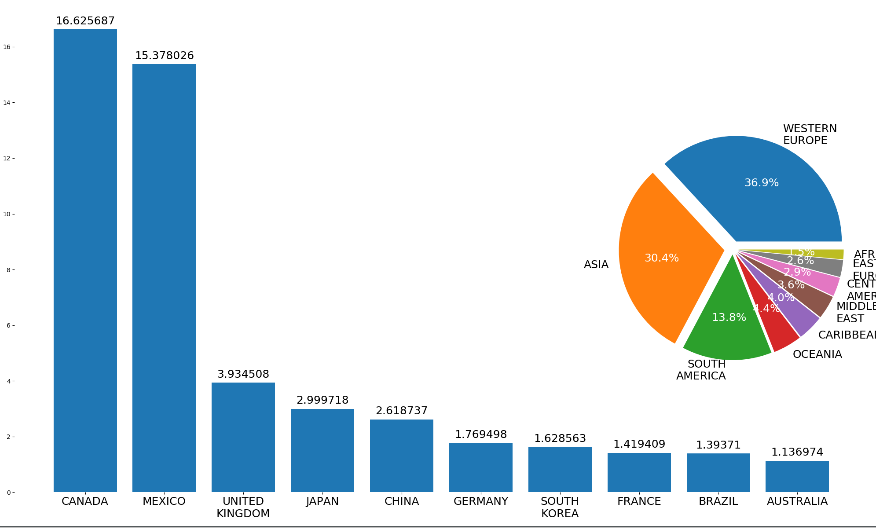
5. 通过一些三角形图案,画出一个猫的形状
import numpy as np from matplotlib.patches import Circle, Wedge, Polygon, Ellipse from matplotlib.collections import PatchCollection import matplotlib.pyplot as plt fig, ax = plt.subplots() patches = [] # Full and ring sectors drawn by Wedge((x,y),r,deg1,deg2) leftstripe = Wedge((.46, .5), .15, 90,100) # Full sector by default midstripe = Wedge((.5,.5), .15, 85,95) rightstripe = Wedge((.54,.5), .15, 80,90) lefteye = Wedge((.36, .46), .06, 0, 360, width=0.03) # Ring sector drawn when width <1 righteye = Wedge((.63, .46), .06, 0, 360, width=0.03) nose = Wedge((.5, .32), .08, 75,105, width=0.03) mouthleft = Wedge((.44, .4), .08, 240,320, width=0.01) mouthright = Wedge((.56, .4), .08, 220,300, width=0.01) patches += [leftstripe,midstripe,rightstripe,lefteye,righteye,nose,mouthleft,mouthright] # Circles leftiris = Circle((.36,.46),0.04) rightiris = Circle((.63,.46),0.04) patches += [leftiris,rightiris] # Polygons drawn by passing coordinates of vertices leftear = Polygon([[.2,.6],[.3,.8],[.4,.64]], True) rightear = Polygon([[.6,.64],[.7,.8],[.8,.6]], True) topleftwhisker = Polygon([[.01,.4],[.18,.38],[.17,.42]], True) bottomleftwhisker = Polygon([[.01,.3],[.18,.32],[.2,.28]], True) toprightwhisker = Polygon([[.99,.41],[.82,.39],[.82,.43]], True) bottomrightwhisker = Polygon([[.99,.31],[.82,.33],[.81,.29]], True) patches+=[leftear,rightear,topleftwhisker,bottomleftwhisker,toprightwhisker,bottomrightwhisker] body = Ellipse((0.5,-0.18),0.6,0.8) patches.append(body) # Draw the patches colors = 100*np.random.rand(len(patches)) # set random colors p = PatchCollection(patches, alpha=0.4) p.set_array(np.array(colors)) ax.add_collection(p) # Show the figure plt.show()
